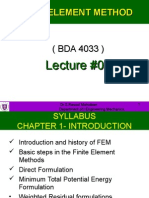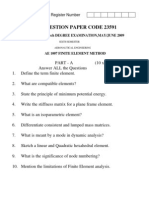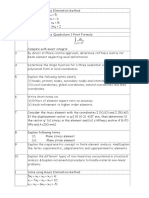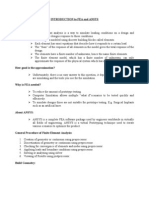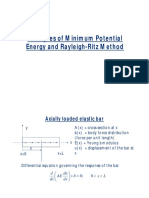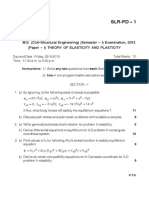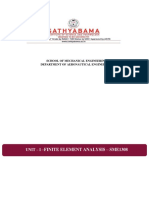Finite Element Method in Structure Assignment-01
Uploaded by
Natinael WoldeFinite Element Method in Structure Assignment-01
Uploaded by
Natinael WoldeBahir Dar University
Bahir Dar Institute of Technology (BiT)
Faculty of Civil and Water Resource Engineering
Post Graduate Program in Structural Engineering
Finite Elements Method in Structures
Assignment-01
Prepared by: Natinael Wolde
ID: BDU1022155
Submitted to: Instructor Seyfe N.
Submission Date: June 4, 2020
Finite Element Method in Structure Assignment -1
#Q-1: Explain the concept of FEM briefly and Outline the procedure.
Answer
The finite element analysis is a numerical technique for solving boundary value problem in
which large domain is divided in to small. In this method all the complexities of the
problems, like varying shape, boundary conditions and loads are maintained as they are but
the solutions obtained are approximate. Because of its diversity and flexibility as an analysis
tool, it is receiving much attention in engineering. The fast improvements in computer
hardware technology and slashing of cost of computers have boosted this method, since the
computer is the basic need for the application of this method. A number of popular brands of
finite element analysis packages are now available commercially. Some of the popular
packages are Abacus, STAAD-PRO, GT-STRUDEL, NASTRAN, NISA and ANSYS. Using
these packages one can analyze several complex structures.
The finite element analysis originated as a method of stress analysis in the design of aircrafts.
It started asan extension of matrix method of structural analysis. Today this method is used
not only for the analysis in solid mechanics, but even in the analysis of fluid flow, heat
transfer, electric and magnetic fields and many others. Civil engineers use this method
extensively for the analysis of beams, space frames, plates, shells, folded plates, foundations,
bridge, rock mechanics problems and seepage analysis of fluid through porous media.Both
static and dynamic problems can be handled by finite element analysis. This method is used
extensively for the analysis and design of ships, aircrafts, space crafts, electric motors and
heat engines.
Thus, the various steps(procedure) involved in the finite element analysis are:
1) Select suitable field variables and the elements.
2) Discretize the continua.
3) Select interpolation functions
4) Find the element properties.
5) Assemble element properties to get global properties.
6) Impose the boundary conditions.
7) Solve the system equations to get the nodal unknowns.
8) Make the additional calculations to get the required values.
Master of Structural Engineering Page 1
Finite Element Method in Structure Assignment -1
#Q-2: Discuss the advantages and disadvantages of FEM over Classical method
Answer
Advantages of FEM over classical
Using finite element method, we are able to
1) Any domain with curved boundaries, heterogeneous material properties, irregular support
constraints including dynamic effects, and varying loading conditions, may be sub-divided
into a suitable number of finite elements, appropriate material and behavior properties may
be ascribed to them ,and the resulting governing equations may be solved quickly and
accurately by computer
2) Handle unlimited number and kinds of boundary conditions
3) Alter the finite element model easily and cheaply
4) Availability of large number of computer software packages and literature makes FEM a
versatile and powerful numerical method.
Disadvantage of Finite Element Method
1) FEM cannot produce exact results(solution) and Output result will vary considerably
2) It requires a digital computer and fairly extensive
3) When solved with the same computer by different analysts, will often result in answers
differing to a smaller or larger degree.
4) If we are not having sound background in mathematics, especially in matrix algebra,
differentiation and integration, then solving problems using FEM is highly difficult.
5) Precision of the output to a larger number of significant digits is no guarantee of the
accuracy of the solution. Even convergence with refinement of mesh is not absolute proof of
the correctness of solution
#Q-3: Draw a typical three-dimensional element and indicate state of the
stress in their positive senses.
Answer: A stress is positive when it is on positive face in positive direction or on negative face
in negative direction. Note that stress on positive face is equal to the stress on negative face plus
rate of change of that stress multiplied by the distance between the faces.
Master of Structural Engineering Page 2
Finite Element Method in Structure Assignment -1
Master of Structural Engineering Page 3
Finite Element Method in Structure Assignment -1
#Q-4: Derive the equations of equilibrium in case of three-dimensional stress system.
Answer: Let the intensity of body forces acting on the element in x, y, z directions be X, Y and
Z respectively as shown below in Figure. The intensity of body forces is uniform over entire
body. Hence the total body force in x, y, z direction on the element shown are given by
X dx dy dz in x– direction
Y dx dy dz in y– direction and
Z dx dy dz in z– direction
Master of Structural Engineering Page 4
Finite Element Method in Structure Assignment -1
Master of Structural Engineering Page 5
Finite Element Method in Structure Assignment -1
Master of Structural Engineering Page 6
Finite Element Method in Structure Assignment -1
#Q-5: State and explain generalized Hooke’s Law.
Answer
The constitutive law expresses the relationship among stresses and strains. In theory of
elasticity, usually it is considered as linear. In one dimensional stress analysis, the linear
constitutive law is stress is proportional to strain and the constant of proportionality is
called Young’s modulus. It is very well known as Hooke’s law. The similar relation is
expressed among the six components of stresses and strains and is called ‘Generalized
Hooke’s Law”. This may be stated as:
#Q-6. Give strain displacement relations in case of a three-dimensional
elasticity problem up to
(i) Accuracy of linear terms only
Master of Structural Engineering Page 7
Finite Element Method in Structure Assignment -1
(ii) Accuracy of quadratic terms.
Answer:
(i) Accuracy of linear terms only
Give strain displacement relations in case of a three-dimensional elasticity problem up to
accuracy of linear terms only are used in small deflection theories. If the displacements and
their derivatives are small,
1. The strains of fibers in one plane are not influenced by the out-of-plane displacements.
2. The undeformed geometry of the body can be used when writing the equilibrium equations.
3. The stress-strain relations are reduced to linear relations
(ii) Accuracy of quadratic terms.
Give strain displacement relations in case of a three-dimensional elasticity problem up to
accuracy of quadratic terms are used in large deflection theories.
Master of Structural Engineering Page 8
Finite Element Method in Structure Assignment -1
#7. Explain the terms, ‘Anisotropic’, ‘Orthotropic’ and ‘Isotropic’ as applied to
material properties.
Answer:
Anisotropic: is the property of being directionally dependent, which implies different
properties in different directions, as opposed to isotropy. Anisotropic induced magnetic field
effects are the result of a local induced magnetic field experienced by a nucleus resulting
from circulating electrons that can either be paramagnetic when it is parallel to the applied
field or diamagnetic when it is opposed to it. Anisotropy is the property of substances to
exhibit variations in physical properties along different molecular axes. { σ }=[ D ] { ε } where D
is 6 x 6 matrix of constant of elasticity to be determined by experimental investigation for
each material.As D is symmetric matrix [ Dij =D ji ] ,there are 21 material properties for linear
elastics Anisotropics materials.
Master of Structural Engineering Page 9
Finite Element Method in Structure Assignment -1
Orthotropic:means not having uniform mechanical and thermal properties in every
direction. Orthotropic materials are a subset of anisotropic materials; their properties depend
on the direction in which they are measured. Orthotropic materials have three axes of
symmetry and Orthotropic properties can be observed in wood, some crystals, rolled
materials, etc. Certain materials exhibit symmetry with respect to planes within the body.
Such materials are called Orthotropic materials. Hence for orthotropic materials, the number
of material constants reduce to 9
Isotropic:refer to elastic properties are same in each and every direction, If the properties
(mechanical, physical, thermal and electrical properties) of a material do not change with
different crystallographic orientations, or in other words, the properties are direction
independent, that material is called isotropic. means having uniform mechanical and thermal
properties in every direction. Isotropic materials have an infinite number of planes of
symmetry and Isotropic properties can be observed in metal, glass, etc. Hence for isotropic
materials, the number of material constants reduce to 12.
#Q-8.Give constitute laws for three dimensional problems of:
(i) orthotropic materials
(ii) isotropic materials.
Answer
(i) orthotropic materials
Certain materials exhibit symmetry with respect to planes within the body. Such materials are
called Orthotropic materials. Hence for orthotropic materials, the number of material
constants reduce to 9 as shown below:
Master of Structural Engineering Page 10
Finite Element Method in Structure Assignment -1
(ii) isotropic materials.
Master of Structural Engineering Page 11
Finite Element Method in Structure Assignment -1
#Q-9: Explain the terms ‘Plane stress’ and ‘Plane strain’ problems. Give
constitutive laws for these cases.
Answer
Master of Structural Engineering Page 12
Finite Element Method in Structure Assignment -1
There are two type of two-dimensional elastic problems, namely plane stress and plane
strain problem.
Plane stress problems: The thin plates subject to forces in their plane only, fall
under this category of the problems. In this, there is no force in the z-direction and
no variation of any forces in z-direction. Hence
plane stress problems the constitutive law reduces to:
plane strains problems: A long body subject to significant lateral forces but
very little longitudinal forces fall under this category of problems. Examples of such
problems are pipes, long strip footings, retaining walls, gravity dams, tunnels, etc.: in
these problems, except for a small distance at the ends, state of stress is represented
by any small longitudinal strip. The displacement in longitudinal direction (z-
direction) is zero in typical strip.
Master of Structural Engineering Page 13
Finite Element Method in Structure Assignment -1
plane strains problems constitutive law reduces to
.
#Q-10: Explain the term ‘Axi-symmetric problems’ and give constitutive law
for such problems
Answer
These are problems in which both the geometry and loading are axisymmetric. Axi-
symmetric structures are those which can be generated by rotating a line or curve about an
axis. Cylinders are the common examples of axisymmetric structures. If such structures are
subjected to axisymmetric loadings like uniform internal or external pressures, uniform self-
weight or live load uniform over the surface, there exist symmetry about any axis. The
advantage of symmetry may be made use to simplify the analysis. In these problems
cylindrical coordinates can be used advantageously. Because of symmetry, the stress
Master of Structural Engineering Page 14
Finite Element Method in Structure Assignment -1
components are independent of the angular (θ) coordinate. Hence all derivatives with respect
to θ vanish i.e. in these cases.
constitutive law for such Axi-symmetric problems is:
#Q-11. Define stiffness matrix and explains its special features.
Answer
stiffness matrix of an element is assembled by direct approach while in FEM though
direct stiffness matrix may be treated as an approach for assembling element properties
(stiffness matrix as far as stress analysis is concerned), it is the energy approached which
has revolutionized entire FEM. Express local (member) force-displacement relationships
in terms of unknown member displacements. The stiffness matrix represents the system
of linear equations that must be solved in order to ascertain an approximate solution to
the differential equation. The ‘stiffness’ method of analysis is a matrix technique on
which most structural computer analysis.
Unknown joint displacements (Dj) are identified and structure is restrained
(kinematically determinate). The number of unknowns in the stiffness method of
analysis is known as the degree of kinematic indeterminacy, that refers to the number
Master of Structural Engineering Page 15
Finite Element Method in Structure Assignment -1
of node/joint displacements that are unknown and are required to describe the
displaced shape of the structure, which are well-defined.
Structure stiffness matrix is formulated and unknown joint displacements (Dj) are
solved
Other unknown quantities in the structure are dependent on the unknown
displacement’s programs are based.
The following special features of matrix displacement equations are worth noting:
1) The matrix is having diagonal dominance and is positive definite. Hence in the solution
process there is no need to rearrange the equations to get diagonal dominance.
2) The matrix is symmetric. It is obvious from Maxwell’s reciprocal theorem. Hence only
upper or lower triangular elements may be formed and others obtained using symmetry.
3) The matrix is having banded nature i.e. the nonzero elements of stiffness matrix are
concentrated near the diagonal of the matrix. The elements away from the diagonal are
zero. Considerable saving is affected in storage requirement of stiffness matrix in the
memory of computers by avoiding storage of zero values of stiffness matrices.
#Q-12: By direct stiffness matrix approach, determine stiffness matrix for
(a) Bar Element
(b) Truss Element
(c) Beam element neglecting axial deformation
(d) Beam element (Frame Element), considering axial deformation also.
Answer
(a) Bar Element
Common problems in this category are the bars and columns with varying cross section
subjected to axial forces, for such bar with cross section A, Young’s Modulus E and length L
(extension/shortening δ) is given by
Master of Structural Engineering Page 16
Finite Element Method in Structure Assignment -1
Master of Structural Engineering Page 17
Finite Element Method in Structure Assignment -1
By giving unit displacement in coordinate direction 1, the forces development in the coordinate
direction1 and 2 can be found (Fig. 3.2 (b)). Hence from the definition of stiffness matrix,
Similarly giving unit displacement in coordinate direction 2 (refer Fig. 3.2 (c)), we get
(b) Truss Element
Members of the trusses are subjected to axial forces only, but their orientation in the plane may
be at any angle to the coordinate directions selected. Figure 3.3 shows a typical case in a plane
truss. Figure 3.4 (a) shows a typical member of the truss with Young’s Modulus E, cross
sectional area A, length L and at angle θ to x-axis
Master of Structural Engineering Page 18
Finite Element Method in Structure Assignment -1
Master of Structural Engineering Page 19
Finite Element Method in Structure Assignment -1
Master of Structural Engineering Page 20
Finite Element Method in Structure Assignment -1
Master of Structural Engineering Page 21
Finite Element Method in Structure Assignment -1
Master of Structural Engineering Page 22
Finite Element Method in Structure Assignment -1
(c) Beam element neglecting axial deformation
In the analysis of continuous beams normally axial deformation is negligible (small
deflection theory) and hence only two unknowns may be taken at each end of an element.
Typical element and the coordinates of displacements selected are shown in below
Figure. The end forces developed due to unit displacement in all the four coordinate
directions are shown in below Figure (a, b,c, d).
Master of Structural Engineering Page 23
Finite Element Method in Structure Assignment -1
(d) Beam element (Frame Element), considering axial deformation also.
Master of Structural Engineering Page 24
Finite Element Method in Structure Assignment -1
If axial deformations in the beam elements are to be considered as in case of columns of
frames, etc. it may be observed that axial force does not affect values of bending moment and
shear force and vice versa is also true. Hence stiffness matrix for the element shown in below
Fig. is obtained by combining the stiffness matrices of bar element and beam element and
arranging in proper locations. For this case
Master of Structural Engineering Page 25
You might also like
- Cell Structure (Grade 6) - Free Printable Tests and Worksheets PDF90% (10)Cell Structure (Grade 6) - Free Printable Tests and Worksheets PDF2 pages
- Thesis Proposal For MEng. Program in Structural Engineering100% (1)Thesis Proposal For MEng. Program in Structural Engineering24 pages
- Finite Element Method in Structure Ass-ALENo ratings yetFinite Element Method in Structure Ass-ALE19 pages
- Finite Element Method in Structures Assignment-5No ratings yetFinite Element Method in Structures Assignment-524 pages
- Shape Functions in Finite Element Method: HandoutsNo ratings yetShape Functions in Finite Element Method: Handouts22 pages
- 3CL1201 Finite Element Method For Structural EngineeringNo ratings yet3CL1201 Finite Element Method For Structural Engineering38 pages
- Finite Element Method in Structure Assignment-4No ratings yetFinite Element Method in Structure Assignment-416 pages
- ME2353 Finite Element Analysis Lecture NotesNo ratings yetME2353 Finite Element Analysis Lecture Notes34 pages
- 2-1 - R 23 - Computer Aided Machine Drawing Lab ManualNo ratings yet2-1 - R 23 - Computer Aided Machine Drawing Lab Manual51 pages
- Me 6603 - Finite Element Analysis: Part A Questions With Answers Unit 1100% (1)Me 6603 - Finite Element Analysis: Part A Questions With Answers Unit 114 pages
- 053 - CE8021, CE6701 Structural Dynamics and Earthquake Engineering - 2 Marks 20% (1)053 - CE8021, CE6701 Structural Dynamics and Earthquake Engineering - 2 Marks 2116 pages
- Me8692 - Finite-element-Analysis - III Year-Vi SemesterNo ratings yetMe8692 - Finite-element-Analysis - III Year-Vi Semester189 pages
- Frequency of Free Damped Vibrations (Viscous Damping)No ratings yetFrequency of Free Damped Vibrations (Viscous Damping)8 pages
- B.tech. - R09 - CSE - Academic Regulations SyllabusNo ratings yetB.tech. - R09 - CSE - Academic Regulations Syllabus2 pages
- 1 Download 2 Download 1 Download 2 Download 3 Download 4 Download 5No ratings yet1 Download 2 Download 1 Download 2 Download 3 Download 4 Download 52 pages
- IDARC 2D Version 4.0 A Program For The Inelastic Damage Analysis of BuildingsNo ratings yetIDARC 2D Version 4.0 A Program For The Inelastic Damage Analysis of Buildings206 pages
- St4211-Numerical and Finite Element Analysis LaboratoryNo ratings yetSt4211-Numerical and Finite Element Analysis Laboratory77 pages
- Assignment Booklet Me2353 Finite Element Analysis Dec 2013 May 2014100% (9)Assignment Booklet Me2353 Finite Element Analysis Dec 2013 May 201485 pages
- ME8692-Finite Element Analysis - 03 - by WWW - Learnengineering.inNo ratings yetME8692-Finite Element Analysis - 03 - by WWW - Learnengineering.in122 pages
- Analysis of Constant Strain Triangular Elemnts Using Matlab For Displacements and Stresses100% (1)Analysis of Constant Strain Triangular Elemnts Using Matlab For Displacements and Stresses41 pages
- Ansys Manual Final Year Anna UniversityNo ratings yetAnsys Manual Final Year Anna University32 pages
- An Introduction To The Finite Element Analysis: Presented by Niko ManopuloNo ratings yetAn Introduction To The Finite Element Analysis: Presented by Niko Manopulo47 pages
- Fea Question With Class Notes and Formula Book50% (2)Fea Question With Class Notes and Formula Book375 pages
- FEM - Cont. & Chapt-1 - Slide PresentationNo ratings yetFEM - Cont. & Chapt-1 - Slide Presentation10 pages
- Analysis & Design of Prestressed Shell Type Structure Using Finite Element MethodNo ratings yetAnalysis & Design of Prestressed Shell Type Structure Using Finite Element Method7 pages
- 2012 Need Based Budget Presentation GondarNo ratings yet2012 Need Based Budget Presentation Gondar76 pages
- Finite Element Method in Structure Assignment-3No ratings yetFinite Element Method in Structure Assignment-39 pages
- Ethiopian Roads Authority Routine Road Maintenance Bill of Quantity100% (9)Ethiopian Roads Authority Routine Road Maintenance Bill of Quantity2 pages
- Lecture Notes - Finite Element Method: January 2020No ratings yetLecture Notes - Finite Element Method: January 20206 pages
- Presentation Report On Union Bank of India: Submitted ToNo ratings yetPresentation Report On Union Bank of India: Submitted To23 pages
- UNIT-5 File Management in C: There Are Two Types of Files in C LanguageNo ratings yetUNIT-5 File Management in C: There Are Two Types of Files in C Language12 pages
- The Colonial Origin of The Social SciencesNo ratings yetThe Colonial Origin of The Social Sciences5 pages
- Betty Azar English Worksheets (Elementary) - Chapter 10 - Expressing Future Time, Part 1No ratings yetBetty Azar English Worksheets (Elementary) - Chapter 10 - Expressing Future Time, Part 124 pages
- Classification of Articulators: Awni Rihani, D.D.S., M.Sc.No ratings yetClassification of Articulators: Awni Rihani, D.D.S., M.Sc.4 pages
- Battery Energy Storage System For Power Conditioning of Renewable Energy SourcesNo ratings yetBattery Energy Storage System For Power Conditioning of Renewable Energy Sources6 pages
- Maintenance Operating and Service ManualNo ratings yetMaintenance Operating and Service Manual16 pages
- Musuko Ga Kawaikute Shikataganai Mazoku No Hahaoya Vol.9 Chapter 200 Successor - ManganeloNo ratings yetMusuko Ga Kawaikute Shikataganai Mazoku No Hahaoya Vol.9 Chapter 200 Successor - Manganelo1 page
- Sell ClickBank Products Using Ebay Classified Ads. (PDFDrive)No ratings yetSell ClickBank Products Using Ebay Classified Ads. (PDFDrive)112 pages
- Cell Structure (Grade 6) - Free Printable Tests and Worksheets PDFCell Structure (Grade 6) - Free Printable Tests and Worksheets PDF
- Thesis Proposal For MEng. Program in Structural EngineeringThesis Proposal For MEng. Program in Structural Engineering
- Shape Functions in Finite Element Method: HandoutsShape Functions in Finite Element Method: Handouts
- 3CL1201 Finite Element Method For Structural Engineering3CL1201 Finite Element Method For Structural Engineering
- 2-1 - R 23 - Computer Aided Machine Drawing Lab Manual2-1 - R 23 - Computer Aided Machine Drawing Lab Manual
- Me 6603 - Finite Element Analysis: Part A Questions With Answers Unit 1Me 6603 - Finite Element Analysis: Part A Questions With Answers Unit 1
- 053 - CE8021, CE6701 Structural Dynamics and Earthquake Engineering - 2 Marks 2053 - CE8021, CE6701 Structural Dynamics and Earthquake Engineering - 2 Marks 2
- Me8692 - Finite-element-Analysis - III Year-Vi SemesterMe8692 - Finite-element-Analysis - III Year-Vi Semester
- Frequency of Free Damped Vibrations (Viscous Damping)Frequency of Free Damped Vibrations (Viscous Damping)
- B.tech. - R09 - CSE - Academic Regulations SyllabusB.tech. - R09 - CSE - Academic Regulations Syllabus
- 1 Download 2 Download 1 Download 2 Download 3 Download 4 Download 51 Download 2 Download 1 Download 2 Download 3 Download 4 Download 5
- IDARC 2D Version 4.0 A Program For The Inelastic Damage Analysis of BuildingsIDARC 2D Version 4.0 A Program For The Inelastic Damage Analysis of Buildings
- St4211-Numerical and Finite Element Analysis LaboratorySt4211-Numerical and Finite Element Analysis Laboratory
- Assignment Booklet Me2353 Finite Element Analysis Dec 2013 May 2014Assignment Booklet Me2353 Finite Element Analysis Dec 2013 May 2014
- ME8692-Finite Element Analysis - 03 - by WWW - Learnengineering.inME8692-Finite Element Analysis - 03 - by WWW - Learnengineering.in
- Analysis of Constant Strain Triangular Elemnts Using Matlab For Displacements and StressesAnalysis of Constant Strain Triangular Elemnts Using Matlab For Displacements and Stresses
- An Introduction To The Finite Element Analysis: Presented by Niko ManopuloAn Introduction To The Finite Element Analysis: Presented by Niko Manopulo
- Analysis & Design of Prestressed Shell Type Structure Using Finite Element MethodAnalysis & Design of Prestressed Shell Type Structure Using Finite Element Method
- Ethiopian Roads Authority Routine Road Maintenance Bill of QuantityEthiopian Roads Authority Routine Road Maintenance Bill of Quantity
- Lecture Notes - Finite Element Method: January 2020Lecture Notes - Finite Element Method: January 2020
- Presentation Report On Union Bank of India: Submitted ToPresentation Report On Union Bank of India: Submitted To
- UNIT-5 File Management in C: There Are Two Types of Files in C LanguageUNIT-5 File Management in C: There Are Two Types of Files in C Language
- Betty Azar English Worksheets (Elementary) - Chapter 10 - Expressing Future Time, Part 1Betty Azar English Worksheets (Elementary) - Chapter 10 - Expressing Future Time, Part 1
- Classification of Articulators: Awni Rihani, D.D.S., M.Sc.Classification of Articulators: Awni Rihani, D.D.S., M.Sc.
- Battery Energy Storage System For Power Conditioning of Renewable Energy SourcesBattery Energy Storage System For Power Conditioning of Renewable Energy Sources
- Musuko Ga Kawaikute Shikataganai Mazoku No Hahaoya Vol.9 Chapter 200 Successor - ManganeloMusuko Ga Kawaikute Shikataganai Mazoku No Hahaoya Vol.9 Chapter 200 Successor - Manganelo
- Sell ClickBank Products Using Ebay Classified Ads. (PDFDrive)Sell ClickBank Products Using Ebay Classified Ads. (PDFDrive)


























